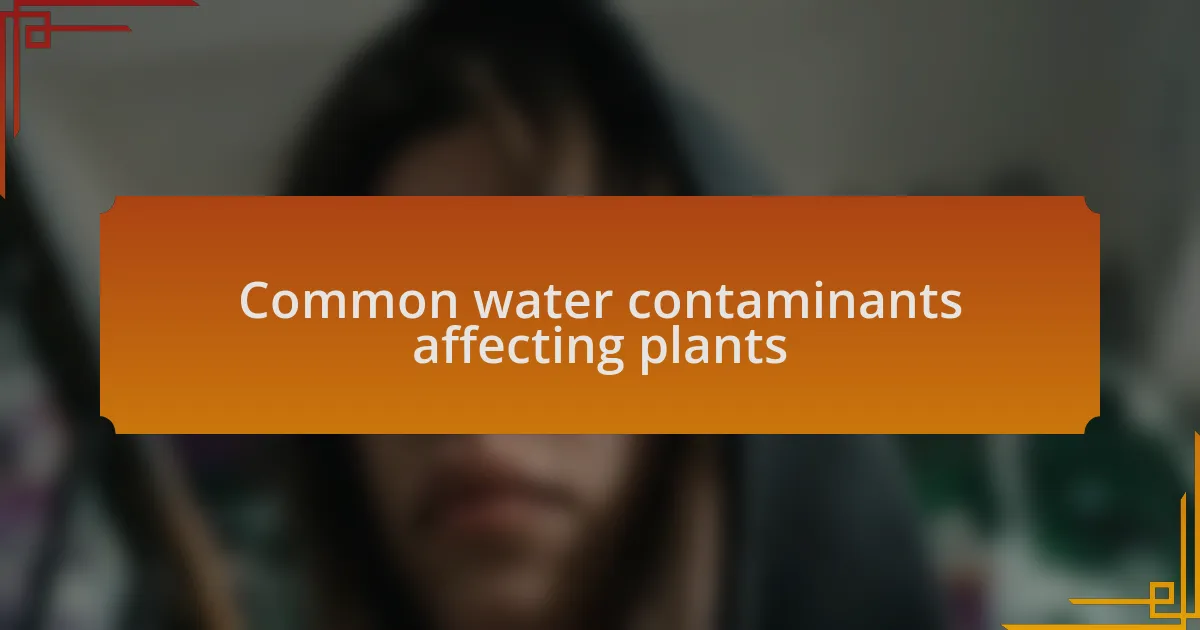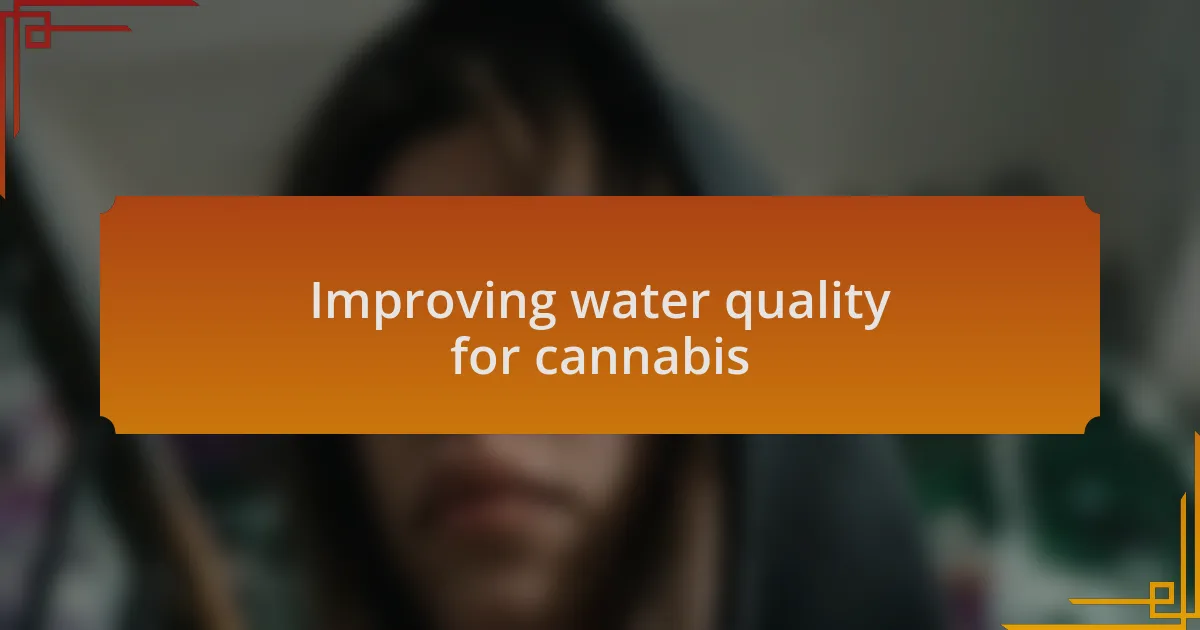Key takeaways:
- Water quality significantly affects cannabis plant health, nutrient uptake, and overall growth.
- Common contaminants like chlorine and heavy metals can hinder plant vitality; testing water quality is essential.
- Using filtered water and maintaining proper pH levels can lead to marked improvements in plant health and crop quality.
- Implementing best practices like regular watering schedules, mulching, and flushing plants can enhance cultivation success.

Understanding water quality importance
Water quality is the cornerstone of healthy plant growth, especially in cannabis cultivation. I remember when I first started growing my own cannabis, I was shocked to learn that poor water quality can lead to nutrient deficiencies and stress in plants. I couldn’t believe that something as simple as water could have such a profound impact, but it transformed my approach to gardening.
Reflecting on my experiences, I’ve realized that the composition of water—whether it contains chlorine, heavy metals, or is too alkaline—matters immensely. Have you ever tasted water and noticed a distinct difference? Just like our own health is impacted by what we consume, cannabis plants thrive in clean, balanced water. When I switched to filtered water, I noticed a remarkable improvement in the vigor and flavor of my crops, elevating my entire growing experience.
It’s not just about the plants; it’s about the end product too. Clean water leads to healthier, more potent cannabis, which ultimately translates into a better experience for consumers. I often ponder how many growers overlook this essential aspect. In my journey, prioritizing water quality has opened doors to richer flavors and more robust effects, reminding me that every detail counts in this craft.

Common water contaminants affecting plants
When I began to investigate water quality for my cannabis plants, I was surprised to discover how prevalent contaminants like chlorine can be. I remember filling my watering can from the tap and catching a whiff of that chemical smell; it really made me wonder what I was introducing to my plants. Chlorine is often used to disinfect municipal water, but it can hinder nutrient uptake in cannabis, leaving my plants less vibrant than I hoped.
Heavy metals are another concern that often flies under the radar. During a particularly rough growing season, I noticed stunted growth that I couldn’t explain. After testing my water, I was shocked to find out that lead levels were higher than acceptable. This led me to realize just how important it is to stay informed about what’s in my water. Have you checked your water quality lately? It may very well be the secret to achieving that bumper crop you’ve been dreaming about.
Then there’s the issue of alkalinity and acidity—elements that can completely alter the nutrient availability for your plants. One memorable experience was realizing my pH levels were off balance after a sudden drop in yield. Adjusting my water’s pH transformed my garden from a struggling patch into a flourishing green paradise. So, what’s the lesson here? Ensuring that your water is within the right pH range can significantly impact your cannabis plants’ health and productivity.

Testing methods for water quality
Testing water quality for cannabis cultivation can be an enlightening process, and I’ve found several methods incredibly useful. One of my favorites is using a simple water testing kit that checks for a variety of contaminants, such as bacteria, nitrates, and pH levels. I remember the first time I tested my water, I was stunned to see just how many different parameters I could evaluate. It felt empowering to have that knowledge at my fingertips.
For more precise results, I’ve turned to lab testing services, especially when I suspect something amiss. Sending a water sample off for professional analysis turned out to be a game-changer for me. The detailed report highlighted contaminants I never even considered, like specific mineral concentrations, that directly influenced my plants’ health. Have you ever considered sending your water for a thorough analysis? It’s an investment that can really pay off in terms of quality.
Sometimes, I rely on intuitive methods as well. While these might not offer the scientific rigor of lab tests, I’ve learned to observe my plants closely. If I notice unusual leaf discoloration or wilting, I usually check my water source again. This gut feeling combined with regular testing has taught me to trust my instincts while also validating them with data. How often do you listen to what your plants are trying to tell you? It can lead you to some surprising discoveries about your water quality.

Personal experience with water quality
When it comes to water quality, my personal journey has been eye-opening. I recall one instance where I used tap water directly from the faucet, thinking it was sufficient. A few weeks into the growth cycle, my plants showed signs of stress, which prompted me to dig deeper. It turns out that the chlorine levels were affecting nutrient absorption. Have you ever felt that moment of panic when your plants just aren’t thriving? It pushes you to learn more about the very foundation of your cultivation efforts.
Switching to filtered water completely transformed my experience. The first time I watered with it, I noticed a remarkable difference almost immediately. My plants perked up, their leaves looked vibrant, and the growth rate accelerated significantly. It’s amazing how something as simple as purifying your water can yield such significant results. I often find myself reflecting on that shift when sharing tips with fellow growers. Could a small change in your water source lead to an equally impressive transformation in your plants?
I’ve also learned the importance of seasonal changes in water quality. One summer, with higher temperatures, I noticed that the local water source was more murky than usual. It was alarming to realize how environmental factors could dictate the quality. I began experimenting with rainwater collection, which felt like a rewarding alternative. Have you tapped into nature’s resources for your watering needs? It’s incredible to see how connecting with the environment around us can enhance our cultivation practices.

Best practices for water use
Best practices for water use
One of the critical lessons I learned was to always check the pH level of my water before using it. Early on, I made the mistake of using water straight from the hose without testing. It wasn’t until I noticed some nutrient lockout that I realized the pH was off. Adjusting it with pH up or down solutions became a routine part of my watering process. Have you ever faced a situation where a simple check could have saved your plants?
I’ve also found that the timing of watering can significantly affect plant health. Initially, I watered whenever I thought of it, often leading to over or under-watering. Now, I stick to a schedule based on the specific needs of my plants, adjusting for environmental conditions. This consistent routine has not only helped with growth but also provided me peace of mind. Have you established a watering schedule that aligns with your plants’ needs?
Utilizing mulch has been another game-changer for me. In my early days, I would let the soil dry out too quickly, leading to wilting plants. Once I started applying a layer of organic mulch around the base, it retained moisture and regulated temperature. This simple practice not only helped my plants thrive, but it also reduced the frequency of watering. Have you considered how a small step like adding mulch can create a healthier growing environment?

Improving water quality for cannabis
Improving water quality for cannabis
One effective strategy I adopted was using filtered or distilled water instead of relying on tap water. Early on, I noticed that the chlorine and other chemicals in tap water were causing stress in my plants, leading to stunted growth. Transitioning to filtered water not only made a visible difference in my plants’ health, but it also gave me confidence in the quality of what I was providing them. Have you ever thought about how just changing your water source might enhance your growing experience?
Another lesson came from implementing a water testing kit that measured not just pH but also dissolved solids and minerals. After a few weeks of regular testing, I discovered that my water had elevated levels of certain minerals that could affect nutrient uptake. This prompted me to adjust both my water source and the nutrients I used. Have you ever realized that a deeper understanding of your water quality could lead to better results in your garden?
Regularly flushing my plants with clean water has also emerged as a crucial part of my routine. Initially, I underestimated the impact of buildup from various nutrients, which made my plants sluggish. I started a monthly flushing regimen, using only water to clear out any accumulated salts and residues. The result was a noticeable boost in vitality and a richer flavor in my harvest. Could taking the time to flush your plants be the key to unlocking their full potential?